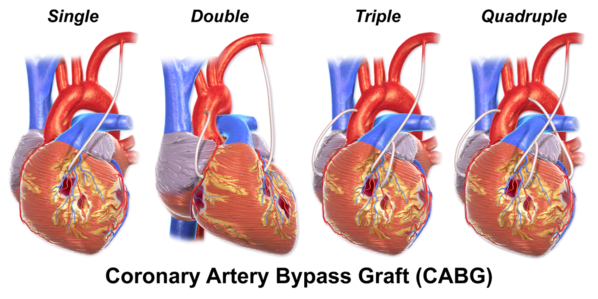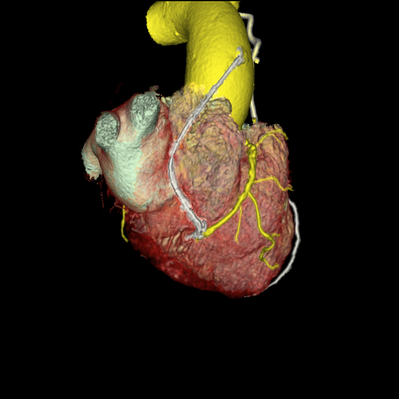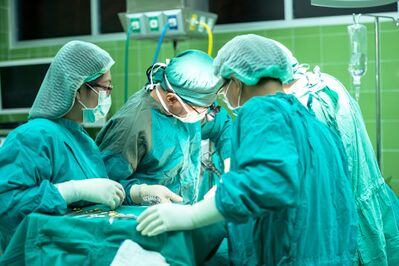Coronary Artery Bypass Graft
Original Editor - Lucinda hampton
Top Contributors - Lucinda hampton, Tahreem Tarique, Kim Jackson and Rucha Gadgil
Introduction[edit | edit source]
Coronary artery bypass grafting (CABG) is a common surgical procedure for the treatment of myocardial ischemia. The surgeon uses an artery or vein of the patient to anastomose from the aorta to the distal end of the stenosis, so that blood flow can directly supply the distal myocardium through the graft, thereby achieving the purpose of treating myocardial ischemia[1].
Image 1: 4 types of CABGs
- Coronary artery bypass grafting remains one of the most commonly performed major surgeries, with well-established symptomatic and prognostic benefits in patients with multivessel and left main coronary artery disease.
- Despite an increasingly higher-risk profile of patients, outcomes have significantly improved over time, with significant reductions in operative mortality and perioperative complications. Five- and 10-year survival rates are ≈85% to 95% and 75%, respectively.
- A number of technical advances could further improve short- and long-term outcomes after coronary artery bypass grafting[2].
Indications[edit | edit source]
CABG is generally recommended when there are high-grade blockages in any of the major coronary arteries and/or percutaneous coronary intervention (PCI) has failed to clear the blockages[3]
Procedure[edit | edit source]
During bypass surgery, the sternum is divided, the heart is stopped for a while and the blood is sent via a heart-lung machine, when the surgery is being performed, to the rest of the body. In contrast with other types of open heart surgery, the heart chambers are not opened while doing a bypass surgery. Depending on the number of arteries that are bypassed it is called as single, double, triple or quadruple bypass[4].
Image 2: Patient underwent CABG for three vessel disease. Bypass grafts were assessed for graft patency (3 bypass grafts can be seen which are patent).
Long term outcome of coronary artery bypass grafting depends on graft patency. Angiography was done for routine assessment of CABG, especially when the patient presented with recurrent angina. However, in the era of cardiac multidetector CT imaging, screening of grafts for patency is quite useful in the early (<1 month) as well as late (>1 month) postoperative period. [5]
Complications[edit | edit source]
- Non-graft related surgical complications: pleural or pericardial effusion; sternal, mediastinal or donor-site infection; sternal non-union; pulmonary embolism; mediastinal haematoma
- Surgery related: Thrombosis - most common in the early postoperative period, due to improper anticoagulation or endothelial damage during surgery; graft malposition or kinking; graft spasm; iatrogenic complications; graft damage during surgery.[5]
Physiotherapy[edit | edit source]
See phases of Cardiac Rehabilitation
Example of Typical Protocol
- Post Surgery Phase 1.
- Phase I of rehabilitation occurring in the hospital is designed to mobilize the patient as soon as possible and to help the patient regain independence in daily life activities.
- It takes 6-8 weeks for the sternum to heal, physiotherapists show the patient the safest ways to lift and move their body, including rolling and sitting in bed. You can learn more about this at Sternal Precautions
Phase 2 and 3 may be part of Cardiac Rehabilitation Program.
2. Phase 2.
Approximately applied for 3 weeks. Should include aggressive education and secondary prevention of cardiovascular events, and provide exercise monitoring.
- Patients qualified for inpatient physiotherapy (InPhysio) train on cycloergometers and had collective gym exercises in the rehabilitation room. Cycloergometer workouts can be held twice a day under the supervision of physiotherapists. The load and type of training (with intervals or continuous) are adapted individually to the patient’s condition. Sessions on cycloergometers take about 20–30 min depending on the capability and strength of the patient. General gymnastics lasts 20 min each day, and breathing exercises with the use of TriFlo should be performed 10 times every hour.
- In addition to pre-scheduled stationary exercises, patients should go for walks outside in good weather conditions.
3. Phase III is a continuation of exercises learned at earlier stages and further reduction of cardiovascular risk factors[6].
Pre Surgery Physiotherapy[edit | edit source]
- A Cochrane review in 2012 found that evidence from small trials suggests that preoperative physical therapy, with an exercise component, for elective cardiac surgery patients reduces postoperative pulmonary complications and length of hospital stay. They concluded that there is a lack of evidence to effect changes to postoperative pneumothorax, or prolonged mechanical ventilation.
- It has been known for some years that inspiratory muscle training provided pre-operatively reduces the risk of anaesthetic complications as well as reducing post-operative complications as well as length of postoperative hospital stay and pulmonary function.
- Pre-operative exercise reduces the length of stay both in Intensive Care facilities and in hospital. A randomised control trial showed positive effects of active cyclic breathing technique and routine physiotherapy on arterial oxygenation, heart rate, and pain perception following Coronary Artery Bypass Graft (CABG) surgery.[7]
References[edit | edit source]
- ↑ Li B, Mao B, Feng Y, Liu J, Zhao Z, Duan M, Liu Y. The Hemodynamic Mechanism of FFR-Guided Coronary Artery Bypass Grafting. Frontiers in Physiology. 2021;12.Available from: https://www.frontiersin.org/articles/10.3389/fphys.2021.503687/full (accessed 20.5.2021)
- ↑ Head SJ, Milojevic M, Taggart DP, Puskas JD. Current practice of state-of-the-art surgical coronary revascularization. Circulation. 2017 Oct 3;136(14):1331-45.Available from:https://www.ahajournals.org/doi/pdf/10.1161/CIRCULATIONAHA.116.022572 (accessed 20.5.2021)
- ↑ Bachar BJ, Manna B. Coronary artery bypass graft. StatPearls [Internet]. 2020 Aug 11.Available from: https://www.ncbi.nlm.nih.gov/books/NBK507836/(accessed 20.5.2021)
- ↑ Pain assist Precautions after CABG Available from:https://www.epainassist.com/chest-pain/heart/precautions-after-bypass-surgery (accessed 20.5.2021)
- ↑ 5.0 5.1 Radiopedia CABGs Available from: https://radiopaedia.org/articles/coronary-artery-bypass-graft(accessed 20.5.2021)
- ↑ Szylińska A, Listewnik M, Rotter I, Rył A, Kotfis K, Mokrzycki K, Kuligowska E, Walerowicz P, Brykczyński M. The efficacy of inpatient vs. home-based physiotherapy following coronary artery bypass grafting. International journal of environmental research and public health. 2018 Nov;15(11):2572.Available from: https://www.ncbi.nlm.nih.gov/pmc/articles/PMC6266912/(accessed 20.5.2021)
- ↑ https://physio-pedia.com/Physical_Activity_Pre_and_Post_Surgery?utm_source=physiopedia&utm_medium=related_articles&utm_campaign=ongoing_internal









